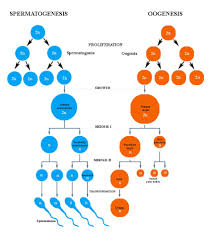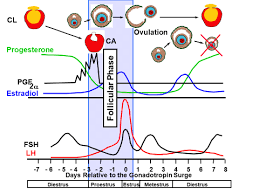This article provides an overview of gametogenesis the development of spermatozoa and ova and examines the oestrous cycle in farm animals, drawing comparisons with the menstrual cycle in primates. Additionally, it discusses abnormal oestrus and deranged cycles.
Gametogenesis: Development of Sex Cells
Gametogenesis is the process by which mature sex cells (gametes) spermatozoa in males and ova in females are developed through consecutive cell divisions and differentiation. In mature mammals, gametogenesis occurs in the gonads, where diploid cells undergo meiosis to produce haploid daughter cells. In males, this process is termed spermatogenesis; in females, it is called oogenesis.
Read Also: How to Grow Paw-Paw (papayas): Beginners Business Guide
Spermatogenesis: Formation of Spermatozoa

The mammalian testis comprises numerous coiled seminiferous tubules, which, in humans, can extend over 200 meters in length. The cells lining these tubules, known as spermatogonia, proliferate by mitosis to produce numerous identical diploid cells.
Under hormonal influence, some spermatogonia transform into primary spermatocytes with large central nuclei, initiating meiosis.
The first meiotic division yields two haploid secondary spermatocytes with smaller, more compact nuclei. These cells complete meiosis to form four haploid spermatids, which are partially embedded in the Sertoli cells situated between developing spermatogonia. Subsequently, while still attached to the Sertoli cells, the spermatids mature into spermatozoa.
This entire process is regulated by follicle-stimulating hormone (FSH) and, in humans, continues steadily from puberty into old age. In other mammals, such as insectivores and herbivorous and carnivorous mammals, testicular activity is seasonal, aligning with the oestrous cycles of females.
It is generally believed that in many mammals, viable sperm are stored at temperatures slightly below normal body temperature. Consequently, the testes and epididymis, where sperm are stored, descend outside the body cavity. This is observed in humans, cattle, sheep, goats, and boars.
Oestrous Cycle: Reproductive Cycle in Female Farm Animals
The ovarian activity in female farm animals is cyclic, unlike the continuous activity observed in males. The pattern of activity and ovulation, known as the oestrous cycle, varies among species but follows a similar structure. Most female mammals exhibit no reproductive behavior during the anoestrous period when the ovary is inactive.
All female mammals, except humans, have a breeding season. If they exhibit a single ovulatory cycle during this period, they are termed monoestrous, as seen in many carnivores, including dogs and cats.
Conversely, if the female undergoes multiple ovulatory cycles during the breeding season, the species is considered polyoestrous, as in horses and other herd animals.
Notably, domesticated mammals often transition from monoestrous to polyoestrous patterns, indicating that environmental factors can induce phenotypic changes.
While the significance of these cycles is not entirely clear, it is certain that the overall breeding pattern enables females to produce offspring when survival prospects are optimal.
In humans, a relatively regular 28-day cycle of ovulation begins with the maturation of a single (or occasionally more) Graafian follicles. Although females may possess a couple of million immature follicles at birth, this number significantly decreases by puberty, with most surviving follicles eventually degenerating.
Within each follicle, meiosis commences but halts at the first prophase stage. Maturation of the ovum occurs only at ovulation, when the primary oocyte completes meiosis II to produce a mature (haploid) ovum and a second polar body. In some species, such as rabbits, this maturation division is completed only after fertilization.
Cells within the ripening Graafian follicle break down to release follicular fluid, and some cells become granular (granulosa cells), forming the cumulus oophorus surrounding the egg.
The egg itself produces the zona pellucida, analogous to the vitelline membrane in lower vertebrates. Within this zona pellucida lies the true egg cell, with its protoplasmic membrane rich in microvilli and a perivitelline space between this membrane and the zona pellucida.
Following follicular rupture, granulosa cells, under the influence of luteinizing hormone (LH), enlarge and become secretory, producing progesterone. If fertilization does not occur, the corpus luteum (the transformed follicle) degenerates, and the oestrous cycle resumes with the maturation of another primary follicle.
Read Also: How To Grow Apple Trees
Oestrous and Ovarian Cycles

The oestrous cycle lasts for 16–25 days in domestic mammals and varies between species and individuals. Events associated with the oestrous cycle can be influenced by exteroceptive factors such as sound, odor, and environmental changes. Pheromones can cause significant shifts in neuroendocrine control mechanisms.
The ovarian cycle refers to the cyclic physiological and morphological changes occurring in the ovary. The oestrous cycle is a concomitant of the ovarian cycle. Changes in the ovary include follicular development, ovulation, corpus luteum formation, and luteal regression, which bring about changes in the lower tract, such as the uterus, cervix, and vagina.
The oestrous cycle may be divided into the following stages, with oestrus onset marking the first day of the cycle, lasting 21 days:
| Stage | Associated Behavior | Duration (days of cycle) |
|---|---|---|
| Proestrus | Excitement | 19–21 |
| Oestrus | Standing for male | 1–3 |
| Metoestrus | Decreasing interest in male | 4–6 |
| Dioestrus | Sexual rest | 7–18 |
These stages are based on behavioral changes. An alternative classification based on the ovarian cycle includes:
i. Luteal Phase: Extends from corpus luteum formation after ovulation to corpus luteum regression at the end of the cycle. Lasts 14–15 days in ewes, 16 days in cows and sows.
ii. Follicular Phase: Period of rapid follicular development, beginning from corpus luteum regression and ending with oestrus and ovulation. Lasts 2–3 days in ewes and goats
Do you have any questions, suggestions, or contributions? If so, please feel free to use the comment box below to share your thoughts. We also encourage you to kindly share this information with others who might benefit from it. Since we can’t reach everyone at once, we truly appreciate your help in spreading the word. Thank you so much for your support and for sharing!

